+ Open data
Open data
- Basic information
Basic information
| Entry | Database: PDB / ID: 9j7k | ||||||
|---|---|---|---|---|---|---|---|
| Title | Structure of AAV8 in the complex of AAV8 with its receptor | ||||||
 Components Components | Capsid protein | ||||||
 Keywords Keywords | VIRUS / AAV8 / complex | ||||||
| Function / homology |  Function and homology information Function and homology informationT=1 icosahedral viral capsid / nucleotide binding / structural molecule activity Similarity search - Function | ||||||
| Biological species |  Adeno-associated virus - 8 Adeno-associated virus - 8 | ||||||
| Method | ELECTRON MICROSCOPY / single particle reconstruction / cryo EM / Resolution: 2.32 Å | ||||||
 Authors Authors | Xu, H. / Wang, G.P. / Su, X.D. | ||||||
| Funding support |  China, 1items China, 1items
| ||||||
 Citation Citation |  Journal: Cell / Year: 2025 Journal: Cell / Year: 2025Title: An alternate receptor for adeno-associated viruses. Authors: Bijay P Dhungel / Hua Xu / Rajini Nagarajah / Joseph Vitale / Alex C H Wong / Divya Gokal / Yue Feng / Mehdi Sharifi Tabar / Cynthia Metierre / Chirag Parsania / Xiaohui Song / Guopeng Wang ...Authors: Bijay P Dhungel / Hua Xu / Rajini Nagarajah / Joseph Vitale / Alex C H Wong / Divya Gokal / Yue Feng / Mehdi Sharifi Tabar / Cynthia Metierre / Chirag Parsania / Xiaohui Song / Guopeng Wang / Xiao-Dong Su / Charles G Bailey / John E J Rasko /   Abstract: Systemic gene therapy using adeno-associated virus (AAV) vectors is approved for the treatment of several genetic disorders, but challenges and toxicities associated with high vector doses remain. We ...Systemic gene therapy using adeno-associated virus (AAV) vectors is approved for the treatment of several genetic disorders, but challenges and toxicities associated with high vector doses remain. We report an alternate receptor for AAV (AAVR2, carboxypeptidase D [CPD]), which is distinct from the multi-serotype AAV receptor (AAVR). AAVR2 enables the transduction of clade E AAVs, including AAV8, and determines an exclusive AAVR-independent transduction pathway for AAV11 and AAV12. We characterized direct binding between the AAV8 capsid and AAVR2 by cryo-electron microscopy (cryo-EM) and identified contact residues. We observed that AAV8 directly binds to the carboxypeptidase-like domain 1 of AAVR2 via its variable region VIII and demonstrated that AAV capsids that lack AAVR2 binding can be bioengineered to engage with AAVR2. Finally, we overexpressed a minimal functional AAVR2 to enhance AAV transduction in vivo. Our study provides insights into AAV biology and clinically deployable solutions to reduce dose-related toxicities associated with AAV vectors. | ||||||
| History |
|
- Structure visualization
Structure visualization
| Structure viewer | Molecule:  Molmil Molmil Jmol/JSmol Jmol/JSmol |
|---|
- Downloads & links
Downloads & links
- Download
Download
| PDBx/mmCIF format |  9j7k.cif.gz 9j7k.cif.gz | 5 MB | Display |  PDBx/mmCIF format PDBx/mmCIF format |
|---|---|---|---|---|
| PDB format |  pdb9j7k.ent.gz pdb9j7k.ent.gz | Display |  PDB format PDB format | |
| PDBx/mmJSON format |  9j7k.json.gz 9j7k.json.gz | Tree view |  PDBx/mmJSON format PDBx/mmJSON format | |
| Others |  Other downloads Other downloads |
-Validation report
| Summary document |  9j7k_validation.pdf.gz 9j7k_validation.pdf.gz | 852 KB | Display |  wwPDB validaton report wwPDB validaton report |
|---|---|---|---|---|
| Full document |  9j7k_full_validation.pdf.gz 9j7k_full_validation.pdf.gz | 1.2 MB | Display | |
| Data in XML |  9j7k_validation.xml.gz 9j7k_validation.xml.gz | 578.1 KB | Display | |
| Data in CIF |  9j7k_validation.cif.gz 9j7k_validation.cif.gz | 854.6 KB | Display | |
| Arichive directory |  https://data.pdbj.org/pub/pdb/validation_reports/j7/9j7k https://data.pdbj.org/pub/pdb/validation_reports/j7/9j7k ftp://data.pdbj.org/pub/pdb/validation_reports/j7/9j7k ftp://data.pdbj.org/pub/pdb/validation_reports/j7/9j7k | HTTPS FTP |
-Related structure data
| Related structure data |  61205MC  9j6zC  9j7lC M: map data used to model this data C: citing same article ( |
|---|---|
| Similar structure data | Similarity search - Function & homology  F&H Search F&H Search |
- Links
Links
- Assembly
Assembly
| Deposited unit | 
|
|---|---|
| 1 |
|
- Components
Components
| #1: Protein | Mass: 81833.047 Da / Num. of mol.: 60 Source method: isolated from a genetically manipulated source Source: (gene. exp.)  Adeno-associated virus - 8 / Production host: Adeno-associated virus - 8 / Production host:  Homo sapiens (human) / References: UniProt: Q8JQF8 Homo sapiens (human) / References: UniProt: Q8JQF8Has protein modification | N | |
|---|
-Experimental details
-Experiment
| Experiment | Method: ELECTRON MICROSCOPY |
|---|---|
| EM experiment | Aggregation state: PARTICLE / 3D reconstruction method: single particle reconstruction |
- Sample preparation
Sample preparation
| Component | Name: adeno-associated virus 8 / Type: VIRUS / Entity ID: all / Source: RECOMBINANT |
|---|---|
| Molecular weight | Experimental value: NO |
| Source (natural) | Organism:  adeno-associated virus 8 adeno-associated virus 8 |
| Source (recombinant) | Organism:  Homo sapiens (human) Homo sapiens (human) |
| Details of virus | Empty: YES / Enveloped: NO / Isolate: SEROTYPE / Type: VIRION |
| Buffer solution | pH: 7.2 |
| Specimen | Conc.: 0.8 mg/ml / Embedding applied: NO / Shadowing applied: NO / Staining applied: NO / Vitrification applied: YES |
| Vitrification | Cryogen name: ETHANE |
- Electron microscopy imaging
Electron microscopy imaging
| Experimental equipment |  Model: Titan Krios / Image courtesy: FEI Company |
|---|---|
| Microscopy | Model: FEI TITAN KRIOS |
| Electron gun | Electron source:  FIELD EMISSION GUN / Accelerating voltage: 300 kV / Illumination mode: FLOOD BEAM FIELD EMISSION GUN / Accelerating voltage: 300 kV / Illumination mode: FLOOD BEAM |
| Electron lens | Mode: BRIGHT FIELD / Nominal defocus max: 2000 nm / Nominal defocus min: 1000 nm |
| Image recording | Electron dose: 60 e/Å2 / Film or detector model: GATAN K3 (6k x 4k) |
- Processing
Processing
| CTF correction | Type: PHASE FLIPPING AND AMPLITUDE CORRECTION |
|---|---|
| 3D reconstruction | Resolution: 2.32 Å / Resolution method: FSC 0.143 CUT-OFF / Num. of particles: 235305 / Symmetry type: POINT |
 Movie
Movie Controller
Controller





 PDBj
PDBj


